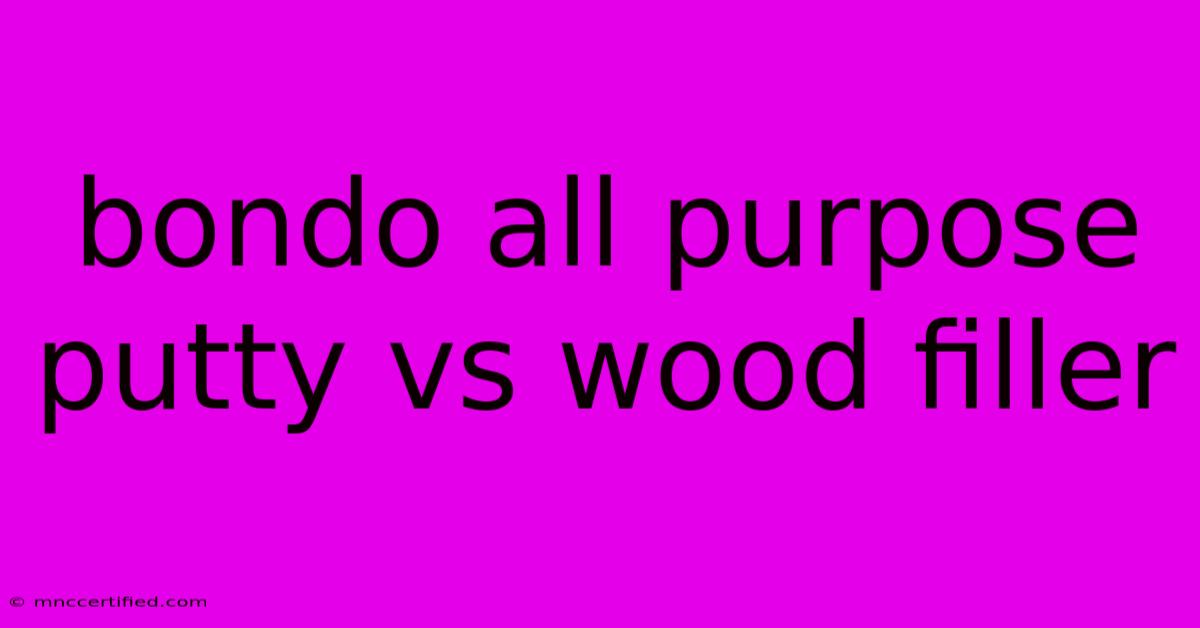Bondo All Purpose Putty Vs Wood Filler

Table of Contents
Bondo vs. Wood Filler: Choosing the Right Material for Your Project
Whether you're patching a hole in your drywall, filling a dent in your car, or repairing a damaged piece of furniture, you'll likely need a filler to smooth out the surface. But with so many options available, it can be hard to know which one is right for your project. Two popular choices are Bondo all-purpose putty and wood filler. Both have their pros and cons, so understanding their differences will help you choose the best material for your needs.
Understanding the Differences
Bondo all-purpose putty is a polyester resin-based filler that is known for its strength, durability, and water resistance. It dries hard and can be sanded smooth for a seamless finish. Bondo is commonly used for automotive repairs, but it can also be used on other surfaces like fiberglass, metal, and wood.
Wood filler is a filler specifically designed for wood. It is typically made from wood fibers mixed with a resin binder, which creates a filler that is easy to work with and blends well with wood surfaces. Wood filler is available in various colors to match the surrounding wood, and it dries to a finish that can be sanded and stained.
Comparing Key Features
Here's a breakdown of the key features of each product:
| Feature | Bondo All-Purpose Putty | Wood Filler |
|---|---|---|
| Material | Polyester resin | Wood fibers and resin binder |
| Strength | High | Moderate |
| Water Resistance | Excellent | Variable |
| Sandability | Excellent | Good |
| Color Options | Limited | Wide range of colors |
| Applications | Automotive repairs, fiberglass, metal, wood | Primarily wood repairs |
| Drying Time | Relatively long (1-2 hours) | Faster (15-30 minutes) |
| Cost | Typically more expensive | Usually less expensive |
Choosing the Right Filler for Your Project
Use Bondo all-purpose putty when:
- You need a strong, durable filler. Bondo is ideal for repairs that need to withstand heavy use and impact.
- You require water resistance. Bondo is excellent for projects exposed to moisture, like boat repairs or outdoor furniture.
- You need a filler that can be sanded smooth. Bondo's smooth finish allows for seamless repairs.
Use wood filler when:
- You're repairing a wooden surface. Wood filler blends seamlessly with wood, providing a natural-looking repair.
- You need a filler that is easy to apply. Wood filler is generally easier to work with than Bondo, especially for beginners.
- You need a filler that dries quickly. Wood filler typically dries faster than Bondo, allowing for quicker project completion.
Additional Considerations
- Surface preparation is key. Both Bondo and wood filler require a clean, dry, and prepared surface for optimal adhesion and durability.
- Proper mixing is essential. Follow the manufacturer's instructions carefully for both products to ensure the filler dries correctly.
- Test the filler on a hidden area. This helps ensure you are happy with the final color and finish before applying it to the entire project.
By understanding the differences between Bondo all-purpose putty and wood filler, you can choose the right material for your specific project and achieve the desired results. Remember to carefully consider the features and applications of each product before making your decision.

Thank you for visiting our website wich cover about Bondo All Purpose Putty Vs Wood Filler. We hope the information provided has been useful to you. Feel free to contact us if you have any questions or need further assistance. See you next time and dont miss to bookmark.
Featured Posts
-
Mcdonalds Health Insurance Enrollment
Nov 09, 2024
-
Scherzinger Faces Backlash Over Russell Brand Comment
Nov 09, 2024
-
Scanly Home Oct Patient Cost Insurance
Nov 09, 2024
-
Cancer Diagnosis Behind Bhad Bhabies Weight Loss
Nov 09, 2024
-
Amika The Kure Bond Repair Conditioner
Nov 09, 2024